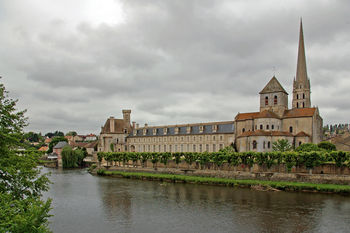Saint-Savin-sur-Gartempe Abbey: Difference between revisions
imported>Richard Nevell (Add illustration) |
imported>Richard Nevell No edit summary |
||
| Line 1: | Line 1: | ||
{{subpages}} | {{subpages}} | ||
{{Image|Saint-Savin-sur-Gartempe Abbey, 2009.jpg|right|350px|The abbey in 2009}} | {{Image|Saint-Savin-sur-Gartempe Abbey, 2009.jpg|right|350px|The abbey seen from across the Gartempe River in 2009}} | ||
'''Saint-Savin-sur-Gartempe Abbey''' was founded in the 9th century, about 30 miles from [[Poitiers]] in [[France]]. The abbey's early history is difficult to decipher as the abbey's records were destroyed in the 14th century.<ref>André Vauchez, Barrie Dobson, and Michael Lapidge (eds.) (2000). ''Encyclopedia of the Middle Ages, Volume 1''. Cambridhe: James Clarke & Co. p. 1,286. ISBN 1-57958-282-6.</ref> It is dedicated to Saint Savin, a 5th-century Christian martyr near whose grave the abbey was built.<ref name=Hansen248>Hansen, David A. (2006). ''Architecture of France''. Westport, CT: Greenwood Publishing Group. p. 248 ISBN 0-313-31902-2.</ref> When the [[Normans]] invaded France in the 9th century, many monastic houses suffered however for a while the Abbey of Saint-Savin-sur-Gartempe escaped such a fate.<ref>Williams, Walkin Wynn (1938). ''Monastic Studies''. Manchester: Manchester University Press. p. 93.</ref> That was the case until 878 when the abbey was sacked and abandoned.<ref name=Hansen248/> | '''Saint-Savin-sur-Gartempe Abbey''' was founded in the 9th century, on the [[Gartempe River]] about 30 miles from [[Poitiers]] in [[France]]. The Benedictine abbey's early history is difficult to decipher as the abbey's records were destroyed in the 14th century.<ref>André Vauchez, Barrie Dobson, and Michael Lapidge (eds.) (2000). ''Encyclopedia of the Middle Ages, Volume 1''. Cambridhe: James Clarke & Co. p. 1,286. ISBN 1-57958-282-6.</ref> It is dedicated to Saint Savin, a 5th-century Christian martyr near whose grave the abbey was built.<ref name=Hansen248>Hansen, David A. (2006). ''Architecture of France''. Westport, CT: Greenwood Publishing Group. p. 248 ISBN 0-313-31902-2.</ref> When the [[Normans]] invaded France in the 9th century, many monastic houses suffered however for a while the Abbey of Saint-Savin-sur-Gartempe escaped such a fate.<ref>Williams, Walkin Wynn (1938). ''Monastic Studies''. Manchester: Manchester University Press. p. 93.</ref> That was the case until 878 when the abbey was sacked and abandoned.<ref name=Hansen248/> | ||
In 1983 the abbey became designated a World Heritage Site by UNESCO, as it is considered to “represent a masterpiece of human creative genius” and “bear a unique or at least exceptional testimony to a cultural tradition or to a civilization which is living or which has disappeared”. The World Heritage Site is named the "Abbey Church of Saint-Savin sur Gartempe".<ref> | The abbey was re-founded in the 11th century, and quickly became one of the most influential religious houses in the region of [[Pitou]]. The oldest surviving part of the abbey complex dates, the church, from this period. The church has been altered since, the 312-foot (95 metres) spire for instance was built in the 14th century. From the mid-15th century the abbey's fortunes took a turn for the worse, and in the 1560s parts of the abbey were burned. The buildings were then allowed to fall into a state of steady decay.<ref name=Hansen248/><ref>"[http://whc.unesco.org/archive/advisory_body_evaluation/230bis.pdf Abbey Church of Saint-Savin sur Gartempe: Advisory Body Evaluation]" (1983), ''UNESCO'', accessed 9 April 2013.</ref> | ||
In 1983 the abbey became designated a World Heritage Site by UNESCO, as it is considered to “represent a masterpiece of human creative genius” and “bear a unique or at least exceptional testimony to a cultural tradition or to a civilization which is living or which has disappeared”. The World Heritage Site is named the "Abbey Church of Saint-Savin sur Gartempe".<ref>"[http://whc.unesco.org/en/criteria/ The Criteria for Selection]", ''UNESCO'', accessed 9 April 2013.</ref><ref>"[http://whc.unesco.org/en/list/230 Abbey Church of Saint-Savin sur Gartempe]”, ''UNESCO'', accessed 9 April 2013.</ref> | |||
==References== | ==References== | ||
{{reflist}} | {{reflist}} | ||
Revision as of 14:00, 9 April 2013
Saint-Savin-sur-Gartempe Abbey was founded in the 9th century, on the Gartempe River about 30 miles from Poitiers in France. The Benedictine abbey's early history is difficult to decipher as the abbey's records were destroyed in the 14th century.[1] It is dedicated to Saint Savin, a 5th-century Christian martyr near whose grave the abbey was built.[2] When the Normans invaded France in the 9th century, many monastic houses suffered however for a while the Abbey of Saint-Savin-sur-Gartempe escaped such a fate.[3] That was the case until 878 when the abbey was sacked and abandoned.[2]
The abbey was re-founded in the 11th century, and quickly became one of the most influential religious houses in the region of Pitou. The oldest surviving part of the abbey complex dates, the church, from this period. The church has been altered since, the 312-foot (95 metres) spire for instance was built in the 14th century. From the mid-15th century the abbey's fortunes took a turn for the worse, and in the 1560s parts of the abbey were burned. The buildings were then allowed to fall into a state of steady decay.[2][4]
In 1983 the abbey became designated a World Heritage Site by UNESCO, as it is considered to “represent a masterpiece of human creative genius” and “bear a unique or at least exceptional testimony to a cultural tradition or to a civilization which is living or which has disappeared”. The World Heritage Site is named the "Abbey Church of Saint-Savin sur Gartempe".[5][6]
References
- ↑ André Vauchez, Barrie Dobson, and Michael Lapidge (eds.) (2000). Encyclopedia of the Middle Ages, Volume 1. Cambridhe: James Clarke & Co. p. 1,286. ISBN 1-57958-282-6.
- ↑ 2.0 2.1 2.2 Hansen, David A. (2006). Architecture of France. Westport, CT: Greenwood Publishing Group. p. 248 ISBN 0-313-31902-2.
- ↑ Williams, Walkin Wynn (1938). Monastic Studies. Manchester: Manchester University Press. p. 93.
- ↑ "Abbey Church of Saint-Savin sur Gartempe: Advisory Body Evaluation" (1983), UNESCO, accessed 9 April 2013.
- ↑ "The Criteria for Selection", UNESCO, accessed 9 April 2013.
- ↑ "Abbey Church of Saint-Savin sur Gartempe”, UNESCO, accessed 9 April 2013.
